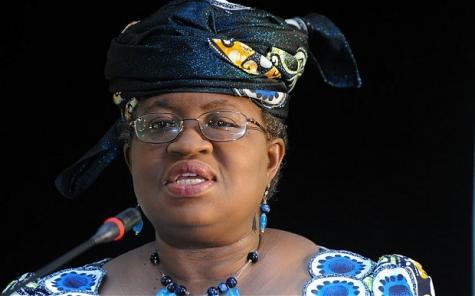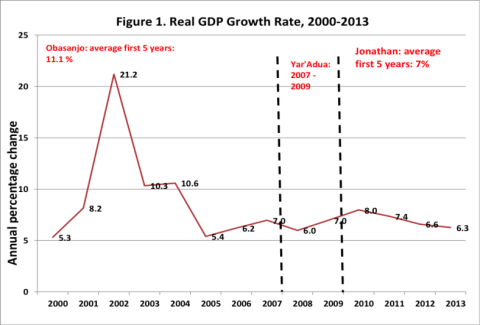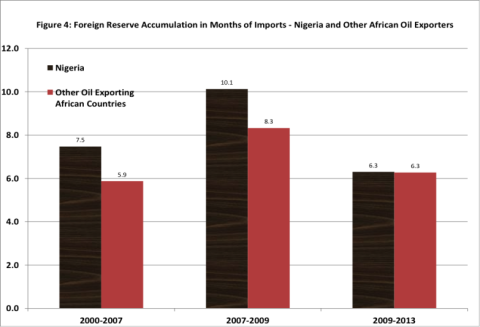
Notwithstanding poor policy choices, unprecedented corruption and theft of public resources, infrastructure deficiency and security challenge, economic growth during the first six years of this administration has been relatively good. However, the performance, as impressive as it may look, is poor when compared to growth during the first six years of civilian rule. In addition, real economic growth does not match the achievement of other oil producing countries with similar endowments as Nigeria.
As is well known, available figures, statistics and ratings show that the Nigerian economy has consistently maintained an unprecedented growth rate of 6-7 per cent under the Jonathan administration. They also show that the Nigerian economy is now the leading economy in Africa and the 26th largest in the world, with a gross domestic product of over $500 billion per annum.

Statistical indicators are like a woman’s bikini, they hide or mask the most important details, while revealing what, to a casual observer, seem like a whole lot. Take for example real economic growth rate: a measure of how much the economy grew, in real terms. Real growth rate is essentially a quantitativemeasure. While it measures the total goods and services produced in a given year, it does not say anything about how the quality of life has changed, and whether or not available resources were used transparently and beneficially.
As a result, economists have come to the conclusion that the growth rate of an economy at any point in time is meaningless unless there is a context to the discussion. Some ways of introducing context is to compare performance to another recent period or to the performance of peer countries with similar economic fundamentals. These two exercises should show whether or not in a particular epoch, a country’s performance is “unprecedented” or spectacular.

In addition, several countries have introduced alternative measures of economic wellbeing that captures more holistically, all aspects of economic performance. Bhutan, for example introduced the concept of Gross National Happiness (GNH) in the 1970s. GNH measures economic performance in relation to four pillars: good governance, sustainable socio-economic development, cultural preservation, and environmental conservation. In the reckoning of Bhutanese authorities, if all the four pillars were performing, the sum total would be higher gross national happiness.
Several factors affect real economic performance. The quantity and quality of a country’s labour force and its natural resource endowment all affect investment, production and consumption decisions of economic agents. In order to steer the economy in a direction that is over and above what is warranted by labour force and endowment, governments would normally introduce fiscal, financial and monetary policies that support the achievement of both a higher level of growth and qualitative improvements in livelihood.
More importantly, because in today’s global environment, countries do not operate as islands unto themselves, developments in the global economy, especially those of major trading partners, international prices of imported and exported commodities, and the general flow of financial resources, all shape a country’s economic outcomes. While the latter are not within the control of a country, sound domestic socio-economic policies on health, education, environment security and infrastructure will improve the overall quality of life and the business environment so as to make the private sector flourish.
Nigeria’s recent economic performance
Nigeria’s recent growth performance has mostly been shaped by improvement in global trends rather than sound economic policy management, which has actually taken a turn for the worse when compared to the first few years of civilian rule. Recent global developments, such as increase in oil prices (until the recent dip in prices); the shift in foreign investor’s interest to developing economies as growth in advanced economies reached saturation points, have helped Nigeria to attract foreign investments, especially in the non-oil sector. As a result, and notwithstanding poor policy choices, unprecedented corruption and theft of public resources, infrastructure deficiency and security challenge, economic growth during the first six years of this administration has been relatively good. However, the performance, as impressive as it may look, is poor when compared to growth during the first six years of civilian rule. In addition, real economic growth does not match the achievement of other oil producing countries with similar endowments as Nigeria.
The facts speak for themselves
During 2009-2013, the first five years of President Jonathan’s administration, real GDP growth averaged 6-7 per cent, a fact often touted by the government. But this record is much lower than that of the first five years of civilian rule (1999 – 2005), when growth averaged 11.1 percent. (Figure 1) This is despite the fact that oil prices were much lower at that time than now, and foreign investors’ appetite for Nigeria was not as strong as now. The difference, it seems, is in the leadership and policy choices of the different periods. Therefore, President Jonathan’s achievement can hardly be said to be “unprecedented”. It’s actually poorer than his predecessor’s achievements in less benign circumstances.

Lying with data? Some glaring inconsistencies
Many Nigerians have wondered how the high growth rates being reported are possible given the “facts on the ground” – to use a well-worn Nigerian phrase. As explained above, decent rates of growth is possible in a chaotic domestic environment so long as external conditions are largely favourable. Notwithstanding, from a strictly conceptual point of view, there are serious reasons to question recent growth data and the integrity of data more generally, as would be clear in the following exposition.
Inconsistencies in regional contributions to growth
To accept current measures of economic performance and the high growth rates, one would have to agree that the disturbances in the North East region, which has brought the regional economy to a halt in the past two years with spillovers to neighboring regions, has not made a dent on growth. Furthermore, one would have to accept that the oil theft in the Niger Delta, which the London think tank, Chatham House, described as “industrial scale” and estimated at $3bn-$8bn a year, did not impact on GDP growth. By any calculation, oil theft at the upper end of this range is enough to lower the growth rate directly by 1-2 percentage points, and much more indirectly through the impact on other sectors of the economy.
Inconsistencies in key macroeconomic indicators
Nigeria’s main macroeconomic indicators have weakened considerably recently, raising questions about why the weakness has not impacted on growth. A few examples will suffice:
Fiscal balances: Nigeria’s fiscal balances are much weaker than at any time since the beginning of civilian regime. In the first five years of President Jonathan, the fiscal account was in deficit, on average by 4 per cent of GDP. During the first five years of civilian rule in contrast, the fiscal balance was in surplus, on average, by close to 2 percent of GDP. (Figure 2) Again, this is despite much lower oil revenue earnings during the earlier period. Even though the Jonathan fiscal deficit remains small by international standards, it is still higher than that of many oil exporting countries which are all accumulating surpluses rather than deficit and using the opportunity of high oil prices to invest in long term infrastructure. What is becoming clear to critical observers is that the budget deficit is more or less contrived through an unrealistic oil benchmark price. With lower revenue and higher expenditure projections, the result is a deficit balance. DMO is then required to “borrow” at excessive cost “to finance the deficit”. But with the usual less than 70 percent implementation rate of the budget, nobody has bothered to find out why there is still a deficit if the budgeted amount was not spent and why the need to accumulate new debt!
Public debt: Public debt stock is much higher than at any time since the Paris Club debt exit of 2006. In 2007, total public debt fell to N2.678 trillion ($3.56billion external debt from $36b, and N2.2trillion domestic debt). But as of end 2013, public debt has increased by more than 300 percent to N8.423trillion ($8.2b external, and N7.1 trillion domestic). (Figure 3).
If AMCON debt and other agencies are included, the total debt burden is now over N10 trillion. By end of 2014, Nigeria’s total debt should easily approach over $100b, most of which were accumulated in the past 6 years. Given the well-established negative correlation of debt and economic growth, how has growth been so strong?
Debt service: According to 2013 federal budget data, close to 20 percent of recurrent expenditure is devoted to servicing debt alone, a contrast to 2007, when only around 10 percent of recurrent expenditure was spent on debt service. The major conundrum is the lack of clarity on why debt accumulation should be so high in the presence of historically high oil prices, and what exactly the debt is financing. Furthermore, government’s policy of accumulating debt at average interest rates of 13-15 percent when the same government is receiving less than 3 per cent on its savings (foreign reserves) beats economic logic. Why not use some of the savings to finance the needs and save 10 percent? It will also be interesting to find out why debt accumulation is bad in 1999-2007, but is now a good thing.
Foreign reserves: Nigeria’s foreign reserves have followed a pattern similar to the other indicators since the beginning of civilian rule. In the Obasanjo and Yar’Adua periods, reserves high enough to finance, on average over 7 and 10 months of imports respectively. However, in the six years of President Jonathan, it has declined to about 6.3 months of imports. (Figure 4). When compared with other oil exporting African countries, in the first two periods, Nigeria’s foreign reserve accumulation was stronger than those of other countries. However, in the recent period, Nigeria is just about catching up with others. Although stabilization funds exist, the federal government has struggled to replenish them, despite high oil prices.

The quality of growth
Apart from the growth rates that do not match economic realities, there are serious questions about the quality of Nigeria’s growth. Sustained growth over the years has not made a dent on poverty, or led to broad-based improvements in living standards. While some indicators improved in the early post military era, many have now nose-dived, as no conscious effort has been made to skew policies in favour of socio economic wellbeing. Some examples:
Life expectancy is just 54 years, eight years lower than in Ghana and 20 years lower than in Brazil.
The rate of childhood malnutrition is 24 percent, more than eight times the rate in Mexico.
Basic literacy among 15- to 24-year-olds is just 66 per cent, compared with 99 per cent in South Africa.
Official estimates of poverty rate vary from 41 per cent to 56 per cent, depending on whether the poverty line is drawn at 2,500 calories per day or at US$1.25 per day. However, according to a recent study, 74 per cent of the population lives below the economic empowerment line. This is a more stringent definition than “poverty line”. As a result, there are still 32 per cent of the population that are above the official calorie-based poverty line but are not “economically empowered."
Infrastructure continues to be a major challenge: electric power, transportation infrastructure, telecommunications infrastructure and Internet and broadband access is limited. Water and wastewater systems are nonexistent outside a few cities.
Reputation for widespread corruption remains high, ranking at 139th out of the 176 countries on Transparency International’s 2014 Corruption Perception Index.
World Bank governance and business environment indicators are much weaker than for oil exporting or African peers. Nigeria ranks 158th out of 189 economies for trading across borders. Global Competitiveness Report of the World Economic Forum for 2013-2014, ranked Nigeria 120th out of 148 countries in the Global Competitiveness Index.
Nigeria’s budgetary process is now adjudged one of the weakest in the world. In the annual “Open Budget” Survey, Nigeria’s ranking has declined progressively since 2006, and in the latest ranking for 2012, Nigeria scored 16 per cent. This does not compare favorably with the performance of South Africa (90%), Uganda (65%), Ghana (50%) and Angola (28%).

The size of the economy
Many Nigerians are somewhat puzzled about the new size of the Nigerian economy relative to their quality of life. Yes indeed, the Nigerian economy is now the largest in Africa, but size does not correlate with quality of life. Apart from a higher per capita income due to the larger size of the economy, many of the other indicators merely confirm that the economy has been underperforming all along, as several indexes now put Nigeria at a much lower ranking than other African countries. Sadly, the government is focusing on trumpeting the good ratios, rather than focusing policies on how to improve some of the poor ratios below:
Though Nigeria’s per capita income rises in line with nominal GDP but it remains well below peer group medians as well as those of oil-producing Angola and Gabon.
FDI now falls to less than 1% of GDP, which shows that Nigeria has one of the lowest levels of FDI inflow in the Africa region.
With non-oil fiscal revenue now falling to around 4% of GDP, the overdependence of the economy on oil is even more stark than in the past, and compared to other countries, Nigeria now has one of the weakest revenue mobilization ratios of Sub-Saharan Africa peers.
Financial market development which is usually measured by money supply in percent of GDP is now just around 19% of GDP. Compared to Mauritius (99 %), South Africa (74 %), Kenya (42 %), and Angola (37 %). These show that Nigeria has one of the least developed financial markets in Africa.

All things considered, the 6-7% of GDP growth rate is neither unprecedented, nor a superior achievement, relative to past governments. The performance is not the result of policy choices, but favourable external environment. While the revision to GDP is a credible exercise that confirms the size of Nigeria’s economy, it also shows how poor performance has been all along. It’s time to focus on better economic outcomes.
Note: PREMIUM TIMES relied on Federal Government of Nigeria publications, International Monetary Funds and World Bank web sites for this report.